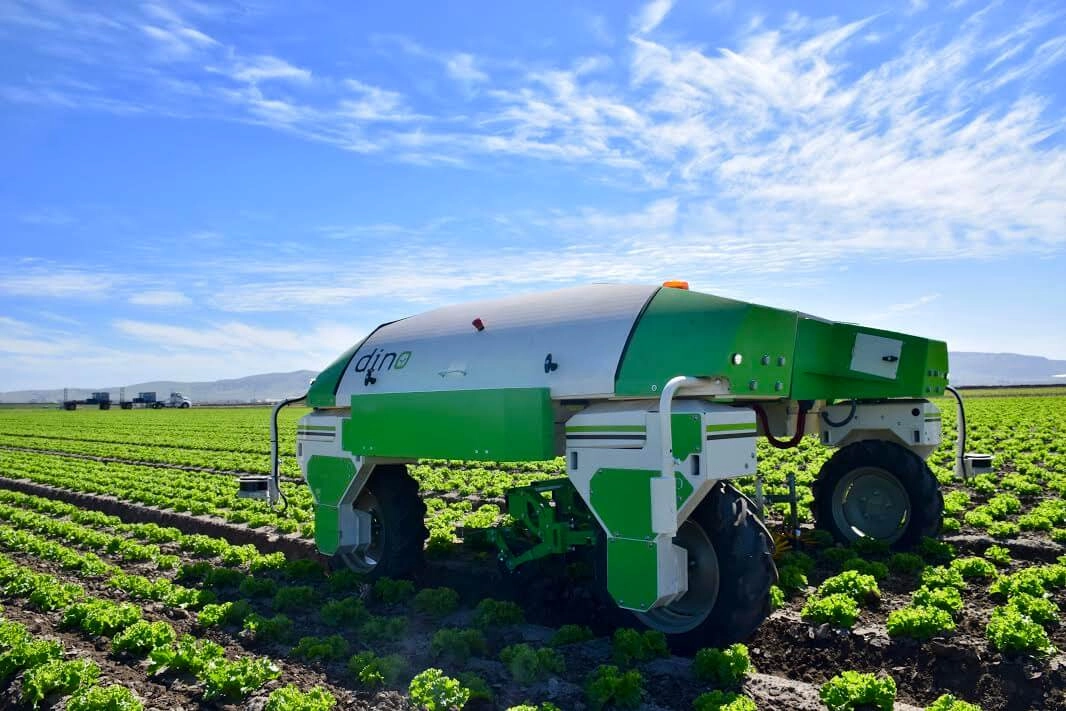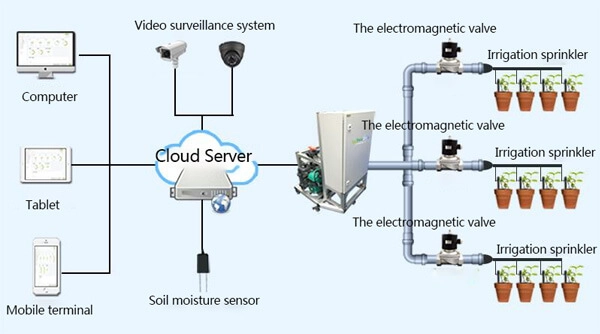With the global population projected to reach approximately 10 billion by 2050, the need for increased agricultural production has become more pressing than ever.1 Leveraging the Internet of Things (IoT), the agricultural sector is transforming into a hub of innovation, utilizing smart technologies like sensor networks and automation to boost productivity, reduce waste, and enhance food security2
Explore IoT agriculture, its use cases, available devices, and best practices on the usage of IoT in agriculture before adopting these systems:
IoT use cases in agriculture
IoT has the potential to transform agriculture in many aspects. In this section, we will look at 5 use cases.
1. Data collection
IoT agriculture enables smart farming through the use of sensors that monitor environmental conditions, soil moisture, and crop growth. The data collected provides farmers with valuable insights into agricultural practices, enabling precision farming technologies to optimize the production process, reduce labor costs, and enhance agricultural output.
Data collection can be on3
- Air monitoring: IoT-based air monitoring systems, utilizing temperature and humidity sensors, are crucial for evaluating microclimates, helping farmers prevent harmful environmental effects on crops and ensuring optimal growing conditions.
- Soil monitoring: IoT systems that monitor soil moisture and temperature through WSNs enable farmers to manage irrigation and optimize crop growth by providing real-time data on soil health and environmental factors.
- Water monitoring: By using IoT sensors to measure parameters like pH, temperature, and turbidity, water monitoring systems help farmers assess water quality, ensuring that irrigation and water usage do not adversely affect crop health.
- Disease monitoring: IoT solutions for disease monitoring enable early detection of fungal diseases and other crop threats by analyzing climate conditions, thereby protecting crops from harmful pathogens and improving yield.
- Monitoring gases in greenhouse: IoT-based greenhouse gas monitoring systems are essential for controlling CO2 and methane levels, ensuring that excess gases do not raise temperatures and negatively impact crop productivity.
- Fertilization and pest control: IoT solutions for fertilization and pest control help farmers optimize nutrient use and control pest populations by analyzing real-time environmental data to improve crop yields while conserving resources.
- Location tracking: IoT-based tracking systems for livestock and crops are essential for preventing theft and monitoring animal health, ensuring that farmers can intervene quickly in case of any issues or anomalies in the field.
Explore data collection automation in more detail.
2. Risk mitigation
By using predictive analytics and data analytics tools, farmers can forecast crop health, monitor environmental data, and prevent disruptions in agricultural production. This foresight allows for better planning of farming operations, ensuring continuous supply chain efficiency and minimizing risks to farming communities.
3. Cost management
Smart agriculture technologies, such as IoT devices and data analytics, enable farmers to monitor and control the use of natural resources like water and fertilizers. Precision agriculture practices, supported by AI technology and smart devices, reduce unnecessary irrigation, conserve energy, and ensure sustainable agricultural practices.
Sensors are there to monitor their use of inputs. This would mean the farmers have precise knowledge of their water consumption, for example.
Scientifically knowing how much water a plant needs for growth, versus the actual amount that it’s being fed, will educate farmers to cut down unnecessary irrigation and to conserve water.4
4. Automation
IoT solutions are transforming agriculture by integrating smart farming technologies like automated irrigation, pest control, and fertilization systems. These innovations streamline farming operations, lower labor costs, and improve energy efficiency, making agricultural production more sustainable and efficient.
5. Enhanced product quality
Quality control is already an aspect of IoT in manufacturing, wherein thermal and other related sensors are able to constantly monitor the quality metrics of produced goods and compare them with the programmed codes to undertake immediate production quality control.
The same technology could be adopted in agriculture, where embedded sensors in the crops’ environment could scan them and make sure their quality is constant across the board. This can be done by monitoring the leaves’ color or root strength.
6. Environmental monitoring
IoT in agriculture extends to environmental monitoring, using smart sensors and weather stations to assess air quality, greenhouse gases, and soil moisture. These agriculture technologies promote sustainability by preserving arable land and improving resource utilization in farming practices.
7. Livestock management
Agriculture IoT devices like GPS technology and connected devices enable farmers to track livestock health and monitor their behavior. Livestock tracking solutions ensure better animal care, optimize agricultural management, and enhance the overall efficiency of farming operations.
IoT devices in agriculture
Some of the IoT devices used in agriculture are:5
1. Robotics in agriculture
Agricultural robots, or Agribots, are transforming farming by automating tasks like weeding, harvesting, and material handling, which addresses labor shortages and boosts productivity across farms.
- Weeding robotics: These robots use digital image processing to identify and eliminate weeds, reducing the need for herbicides and benefiting both the environment and farm economics.
Figure 1. A weeding robot

Source: Modern Farmer6
- Harvesting robotics: Agribots are employed for the delicate task of picking crops, like apples and strawberries, operating 24/7 to ensure high-quality harvests and reduce labor costs.
- Material handling robots: These robots assist with tasks such as lifting heavy materials and spacing plants accurately, optimizing farm space, and improving operational efficiency.
2. Drones in agriculture
Drones, including aerial and ground-based types, are key in optimizing farming practices by surveying fields, monitoring crop health, performing crop spraying, and gathering soil data.
Figure 2. An aerial drone flying over a lush green field

Source: LOVE AND TRACTORS BLOG7
- Aerial drones: Flying UAVs provide farmers with valuable insights from crop health monitoring to yield predictions, using sensors and GPS for accurate assessments and decision-making.
- Ground drones: These bots, equipped with wheels, survey fields and gather data on soil and plant conditions, complementing aerial drones for a comprehensive view of farm health.
3. Remote sensing in agriculture
IoT-powered remote sensing systems deploy sensors across farms to monitor environmental factors like soil moisture, weather conditions, and crop health, transmitting data for actionable insights.
Figure 3. Representation of how irrigation sensors work

Source: Renke8
- Crop monitoring: Sensors track variables such as temperature, humidity, and growth metrics, alerting farmers to potential issues like disease or nutrient deficiency.
- Weather monitoring: Data on weather conditions, like temperature and humidity, helps farmers adjust crop management practices to suit changing environmental factors.
- Irrigation sensors: These smart agriculture sensors monitor soil moisture levels and regulate irrigation systems to prevent over or under-watering, optimizing water use and crop growth.
- Soil sensors: Embedded in the field, these sensors track soil conditions and provide data on temperature, moisture, and crop health to assist farmers in making informed decisions.
4. Navigation machine
Automated tractors and plowing equipment equipped with GPS and IoT technologies autonomously perform fieldwork with precision, reducing the need for manual labor while ensuring consistent results.
IoT sensors such as GPS attached to livestock help farmers monitor animal health, behavior, and location, improving productivity and facilitating early intervention in case of health issues.
Best practices to adopt IoT in agriculture
To achieve business goals of implementing IoT, farmers can follow best practices of IoT implementation in agriculture, including:
1. Choosing the right hardware
An IoT ecosystem is only as strong as its building blocks, meaning you need to choose the sensors, devices, and databases (be it on the cloud or on-premise) best catered to your solution.
2. Connectivity
Even if all previous conditions are met, all the pieces in the chain need to be connected to each other via reliable communication protocols that do not cause a disruption in continuity.
3. Leveraging analytics
The data gathered is rendered useless if not followed by insightful action. That is why purchasing data analytics tools parallel with your IoT devices is paramount if you want to make heads or tails of the gathered data, and to actually build upon the information gathered.
With analytics, farmers can predict the volume and quality of yields in advance, as well as calculate their crops’ vulnerability to unfavorable weather conditions. These data will help the farmer make an informed decision.
4. Monitoring IoT architecture
If you decide to let the technology take care of irrigation, planting, harvesting, or other menial tasks, while you are attending to more important tasks at hand, then you need to invest in proper IoT monitoring tools that constantly keeps track of the devices’ functionality, continuity, health, and progress.
5.Ensuring data security
IoT technology works with large sets of data, gathered from every corner of your business, regardless of your sector. This puts the integrity of your network at risk of being attacked and your data exploited.
For example, a drone that transmits data to farm machinery connects to the internet but has little to zero security protection. To counter these threats, consider investing in cybersecurity platforms that safeguard the integrity of your digitized business.
What is IoT agriculture?
Broadly speaking, IoT in agriculture refers to the use of smart devices and sensors to monitor the farming process, from planting to farming to harvesting and finally to distribution.
By using IoT sensors, farmers are able to collect environmental data (e.g. rainfall, humidity, pollution, etc.) to make data-driven decisions to improve the different aspects of the farming process.
One example is sensors monitoring the state of soil and enabling farmers to know the exact amount of pesticides and fertilizers that they have to inject into it in order to reach optimal growth efficiency.
Why agricultural industry needs IoT technologies
Growing populations, limited resources
By 2050, the U.S. population will reach 400 million. Globally, we’ll be nearly 10 billion. Feeding everyone will be a challenge. At the same time, farmland, fresh water, and energy are limited.9
Farming consumes a lot
Today, farming uses about 70% of the world’s fresh water. Energy is one of the biggest costs for farmers. Plus, overusing fertilizers and chemicals is harming the environment.
We need to be smarter
To protect food, energy, and water supplies, we need to grow more with less. That means using smarter tools—like Internet of Things (IoT) technologies.
What IoT Can Do
IoT (Internet of Things) means using smart devices to collect and share real-time data. In farming, this means:
- Sensors in soil that measure moisture and help save water
- Drones that scan crops to check health and spot problems early
- GPS-guided equipment that reduces fuel and chemical use
- Smart irrigation systems that water crops only when needed
These tools help farmers grow more food using fewer resources.
For more on IoT
If you are curious about learning more about IoT’s applications in different sectors, read:
- The Ultimate Guide into IoT in Retail: Benefits, Challenges, & Case Studies
- IoT Could Guide Your Next Real Estate Purchase
- Top 10 Components of IoT Architecture
External Links
- 1. The future of food and agriculture–trends and challenges. Food and Agriculture Organization of the United Nations. Food and Agriculture Organization of the United Nations. Accessed: January/13/2025.
- 2. Ande, P., & Rojatkar, D. (2017). A survey: application of IoT. International Research Journal of Engineering and Technology, 4(10), 347–350.
- 3. Farooq, M. S., Riaz, S., Abid, A., Umer, T., & Zikria, Y. B. (2020). Role of IoT technology in agriculture: A systematic literature review. Electronics, 9(2), 319.
- 4. Chazarra-Zapata, J., Parras-Burgos, D., Arteaga, C., Ruiz-Canales, A., & Molina-Martínez, J. M. (2020). Adaptation of a traditional irrigation system of micro-plots to smart agri development: A case study in murcia (Spain). Agronomy, 10(9), 1365.
- 5. IoT in agriculture: For real-time farm monitoring.
- 6. Futuristic Farming Has Arrived with Weeding Robots - Modern Farmer. Modern Farmer
- 7. Put Your "Drones" Up In The Air: Drones in Agriculture And Where We Use Them. LoveAndOtherTractors
- 8. Best Soil Moisture Sensor For Automatic Irrigation System - Renke.
- 9. IoT4Ag | About Us. Internet of Things for Precision Agriculture


Comments
Your email address will not be published. All fields are required.